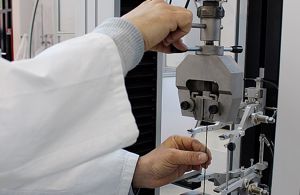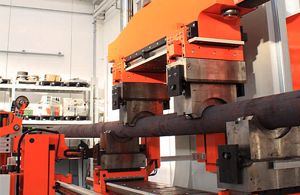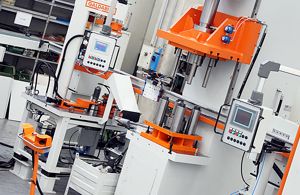-
Product Lines
Material testing machines for quality control

Automatic straightening machines for shafts, profiles

Hydraulic presses, Trimming beading and Automatic production lines

- Company
- Service
- Calibration
- Community
- Contacts
- Library
ISO 527-3, ASTM D 882
This test allows to determine properties as tensile strength, yield strength, yield strain, strain at break, and modulus of elasticity. Due to the flexible, delicate nature of these plastic specimens, both gripping and strain measurement can be a challenge
Specimens are easily produced by a cutting press or a film cutting device. Dumbbell specimens are often used for quality control and require a direct measuring extensometer for strain acquisition directly on the specimen. For tests on strips the results for strain at break depend on the shape and the clamping type of the specimen. 25 mm x 25 mm rubber grip face size is commonly used for this material, that matches the width of the gripped or tabbed end of the specimen. The matching width allows for ease of specimen alignment, which is critical for good breaks and accurate test results. The gripping must prevent slipping of the material at relatively high loads but not tear into the material and cause premature specimen failure
We suggest to use parallel grips for applying enough pressure to avoid specimen slippage as premature failure and Video Extensometer to measure accurately strain values. The measuring principle is based on intelligent image analyses of two contrast marks on the specimen. The marks will be identified and the displacement will be evaluated as elongation depending on the gage length. Marking with paint pens and marking templates are provided with the instrument. Non-contacting video extensometry is usually the best solution, as typical clip-on extensometers weigh down the specimen, while knife edges tear at the specimen - both affecting test results
Our testing software has advanced pre-built methods available with pre-configured plastic specific calculations helping to ensure compliance. Using features such as an appropriate preload is critical for achieving accurate, repeatable results. A preload eliminates the compressive forces on a specimen that often occur when initially placed into grips